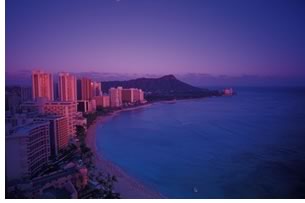

12/2004
Honolulu receives Gold Award as the world’s most livable community
 The United Nations-endorsed
International Awards for Livable Communities (LivCom) awarded Honolulu
its first-place Gold Award as the most livable, sustainable large city
in the world. The city, cited for “its innovation and leadership
in planning, building, and managing sustainably,” was one of 48
communities from 20 counties selected as finalists to participate in
the competition held in Niagara, Canada.
The United Nations-endorsed
International Awards for Livable Communities (LivCom) awarded Honolulu
its first-place Gold Award as the most livable, sustainable large city
in the world. The city, cited for “its innovation and leadership
in planning, building, and managing sustainably,” was one of 48
communities from 20 counties selected as finalists to participate in
the competition held in Niagara, Canada.
“This award is the result of a long-term effort to make Honolulu the greatest city in the world,” said the Hon. Jeremy Harris, Honolulu mayor and public director on the AIA national Board. “It’s gratifying to know that in the eyes of the global community, our city is viewed as the leader in protecting the environment, preserving cultural and historical resources, and empowering citizens to be involved in shaping the future. This is unquestionably the highest honor our city could have.”
AIA Honolulu’s incoming president, Patrick T. Onishi, AIA, credited Mayor Harris for sustaining a vision of Honolulu that made possible the livable community award. “Honolulu has received this well-deserved recognition because planning and strong leadership came together to underscore the importance of design in developing and integrating our natural and built environments,” said Onishi. “On behalf of the architecture community, I want to congratulate and thank Mayor Harris for his leadership in making Honolulu the beautiful city that it is. Community pride is an important byproduct of everything the mayor has done.”
Myriad good reasons for the award
The LivCom award serves as a testament to the city’s efforts to improve
the quality of life by promoting sustainable tourism and perpetuating Hawaii’s
environmental and cultural heritage through such initiatives as the revitalization
of Waikiki. Specific initiatives that Honolulu has undertaken include:
- Improvements to the facilities at Hanauma Bay
- Establishment of world-class athletic facilities at Waipio Peninsula and Central Oahu
- Use of the “H-Power” waste-to-energy system that uses incineration and recycling to reduce landfill disposal by 90 percent
- A water reclamation facility that recycles wastewater for commercial and agricultural purposes
- A comprehensive energy program aimed at slashing electrical demand by using renewable energy, including the city’s cogeneration facility, which has reduced grid energy demand by as much as 80 percent
- Conversion of more than 1,000 city vehicles to use bio-diesel fuel
- LED traffic lights at an annual electrical savings of more than $250,000
- An integrated transportation plan that addresses changing travel patterns, increases service to smaller communities, and features state-of-the-art hybrid-electric vehicles
- Establishing urban growth boundaries and directing growth to Oahu’s urban core to curtail sprawl
- Protection of shoreline areas
- Support of island agriculture by advancing an initiative to save 83,000 acres of agricultural land in perpetuity.
LivCom also recognized Honolulu for encouraging citizen involvement in land use, neighborhood restoration, and transportation planning processes. The city also received high marks for initiatives, such as “Sunset on the Beach” and “Brunch on the Beach,” that develop community pride and address the island’s unique economic challenges.
Copyright 2004 The American Institute of Architects.
All rights reserved. Home Page ![]()
![]()
 |
||
Learn more
about the LivCom Awards. Read about Honolulu’s comprehensive recycling program, and
hear their recycling song, “Got Me a Paradise” by Henry
Kapono.
|
||